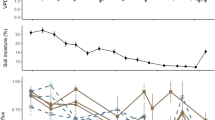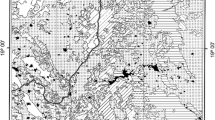Summary
Field measurements of water relations were used to examine the response of mature Quercus palustris (20 m tall), a flood tolerant tree, to experimental flooding treatments. Flooding treatments included: 1) flooding in the dormant season, 2) short-term flooding in the growing season and 3) long term (<2 years) continuous flooding. Dormant season flooding had no apparent effect on phenology or physiology during the following growing season. Short term flooding in the growing season caused immediate but reversible stomatal closure without significant development of water stresses. Within 10 days after the growing season flooding treatment water relations measurements were not significantly different from pre-treatment measurements or controls. Although no significant differences in water relations were found in growing season measurements on continuously flooded trees, continuous flooding reduced reproductive fitness and caused premature autumn coloration and leafabscission.
Unlike upland Quercus species, Quercus palustris does not show evidence of water limitation late in the growing season. Stomatal conductance increased early in the growing season but showed no clear mid- to late-growing season trends. No evidence of mid-day stomatal closure was found throughout the growing season. Stomatal conductance was correlated to both xylem pressure potential and photosynthetically active radiation. Combined osmotic and matric potentials decreased to-2.43 MPa by Julian day 140 and remained constant throughout the growing season. Predawn xylem pressure potentials exceeded-0.4 MPa throughout the growing season.
Similar content being viewed by others
References
Burrows WJ, Carr DJ (1969) Effect of flooding the root system of sunflower plants on the cytokinin content in the xylem sap. Physiol Plant 22:1105–1112
Crawford RMM (1982) Physiological responses to flooding. In: OL Lange, PS Nobel, CB Osmond and H Ziegler (eds) Physiological plant ecology II. Water relations and carbon assimilation. Springer, Berlin Heidelberg New York p 747
Elfving DC, Kaufmann MR, Hall AE (1972) Interpreting leaf water potential measurements with a model of the SPAC. Physiol Plant 27:161–168
Fredrickson LH (1979) Floral and faunal changes in lowland hardwood forests in Missouri resulting from channelization, drainage and impoundment. US Dept of Interior, FWS/OBS-78/91, p 131
Gambrell RP, Patrick WH (1978) Chemical and microbiological properties of anaerobic soils and sediments. In: DD Hook and RMM Crawford (eds) Plant life in anerobic environments. Ann Arbor Science Publishers, p 564
Gee GW, Federer CA (1972) Stomatal resistance during senescence of hardwood leaves. Water Resources Res 8:1456–1460
Gill CJ (1970) The flooding tolerance of woody species — a review. For Abst 31:671–688
Green WE (1947) Effect of water impoundment on tree mortality and growth. J For 45:118–120
Grime JP (1979) Plant strategies and vegetation processes. John Wiley and Sons, New York, p 222
Hinckley TM, Lassoie JP, Running SW (1978) Temporal and spacial variations in the water status of forest trees. For Sci Monogr 20:1–72
Hook DD, Schottens JR (1978) Adaptations and flood tolerance of tree species. In: DD Hook and RMM Crawford (eds) Plant life in anaerobic environments. Ann Arbor Science Publishers, p 564
Kanemasu ET, Thurtell GW, Tanner CG (1969) Design, calibration and field use of a stomatal diffusion porometer. Plant Physiol 44:881–885
Keeley JE (1979) Population differentiation along a flood frequency gradient: physiological adaptations to flooding in Nyssa sylvatica. Ecol Monogr 49:89–108
Kozlowski TT, Pallardy SG (1979) Stomatal responses of Fraxiuus pennsylvanica seedlings during and after flooding. Physiol Plant 46:155–158
Mayo JM (1974) A thermocouple psychrometer chamber for field and laboratory use. Can J Plant Sci 54:597–598
Morrow PA, Slatyer RO (1971) Leaf resistance measurements with diffusion porometers: precautions in calibration and use. Agr Meteor 8:223–233
Parker J (1950) The effects of flooding on the transpiration and survival of some southeastern forest tree species. Plant Physiol 25:453–460
Pereira JS, Kozlowski TT (1977) Variations among woody angiosperms in response to flooding. Physiol Plant 41:184–192
Ponnamperuma FN (1972) The chemistry of submerged soils. Adv Agron 24:29–96
Railton ID, Reid DM (1973) Effects of benzyladenine on the growth of waterlogged tomato plants. Planta 111:261–266
Regehr DL, Bazzaz FA, Boggess WR (1975) Photosynthesis, transpiration and leaf conductance of Populus deltoides in relation to flooding and drought. Photosynthetica 9:52–61
Rogers R (1984) Flooding, stand structure and stand density affect pin oak growth in southeastern Missouri. SJ Appl For (in press)
Tang ZC, Kozlowski TT (1982a) Some physiological and morphological responses of Quercus macrocarpa seedlings of flooding. Can J For Res 12:196–202
Tang ZC, Kozlowski TT (1982b) Physiological, morphological and growth responses of Plantanus occidentalis seedlings to flooding. Plant Soil 66:243–256
Thompson DR, Hinckley TM (1977) A simulation of water relations of white oak based on soil moisture and atmospheric evaporative demand. Can J For Res 2:400–409
Wample RL, Reid DM (1975) Effect of aeration on the flood-induced formation of adventitious roots and other changes in sunflower (Helianthus annus L.). Planta 127:263–270
Wample RL, Reid DM (1979) The role of endogenous auxins and ethylene in the formation of adventitous roots and hypocotyl hypertrophy in flooded sunflower plants (Helianthus annuus). Physiol Plant 45:219–226
Waring RH, Franklin JF (1979) Evergreen coniferous forests of the Pacific Northwest. Science 204:1380–1386
Author information
Authors and Affiliations
Additional information
This paper is Scientific Paper SP 6421 of the College of Agriculture Research Center, Washington State University. Work was conducted under Project 0549, ARC-WSU and project 169, 170, 183 of the Missouri Agricultural Experiment Station, University of Missouri. The author acknowledges the support of the Missouri Department of Conservation and the U.S. Fish and Wildlife Service. James Ware and Leigh Fredrickson provided assistance and support without which the project would not have been possible
Rights and permissions
About this article
Cite this article
Black, R.A. Water relations of Quercus palustris: field measurements on an experimentally flooded stand. Oecologia 64, 14–20 (1984). https://doi.org/10.1007/BF00377537
Received:
Issue Date:
DOI: https://doi.org/10.1007/BF00377537




